In the spirit of Charles Ives, Carl Stallings, and Frank Zappa, I wanted my audience to enjoy poking fun at the chain-of-command societal structure: to let the music inspire humor towards the feelings of powerlessness we often find ourselves in at work, in every level of politics, bureaucracy, church, school – almost everywhere that a hierarchical system exists. Set in the Industrial Revolution era, the trio music presents a three-voiced march tune where each of the three voices is unique enough to represent a character: The Tycoon, The Supervisor, and The Worker. With the tireless help of Benoit Glazer, this happened.
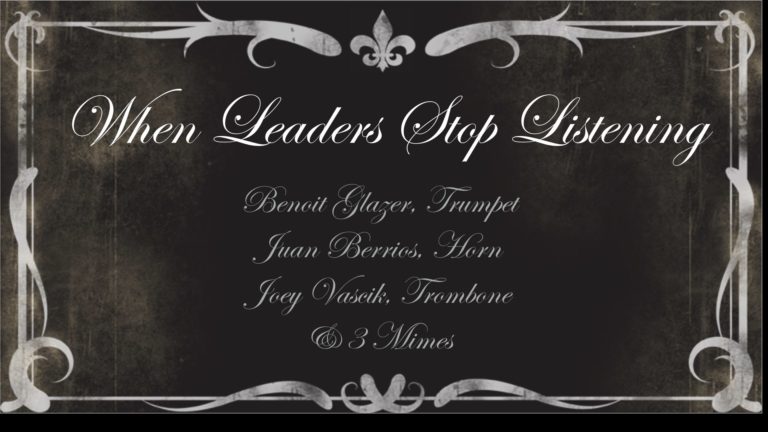
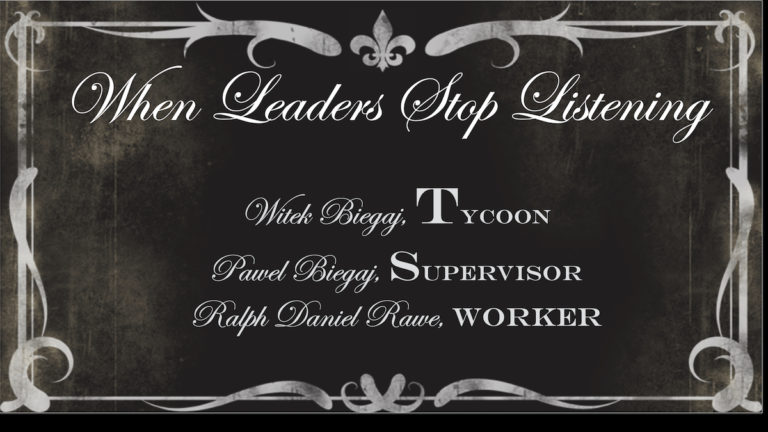
the experiment
How are ideas perceived? Especially those in modern music? Audiences want to understand the sounds they hear but are sometimes not familiar enough with modern constructions to do so. The original version of this satire was pure music, but family, friends, and other musicians could not well imagine the plot – even when they knew that the trumpet was the Boss, the horn was Management, and the trombone the Worker. The score included notes on what was happening to help the musicians tell the story. My first solution was to project a slideshow that told the story with text with the music. Later, at one of our Central Florida Composers Forum meetings, I asked fellow member Benoit Glazer if he thought it possible to find mimes to take the story to its ultimate expression with live acting. He explored the possibility with co-workers at Cirque du Soleil La Nouba here in Orlando – who agreed to take part! Professional Mimes could tell the story magnificently in time with the music. In Vaudeville of the early 20th c, music was written to support the action. For “When Leaders Stop Listening,” the actors also support the music. The question was: Would the visuals take over the musical experience? What would be remembered – the visuals or the sounds?
the Music
The trumpet music represents the Tycoon, who is creative and bold. But, he lets success get to his head and considers himself intrinsically unique. He both inspires his employees and angers them. He is usually distant from his workforce, selling the product and generating income. The Tycoon’s theme, circled in red, is the melody. When he’s pressuring the company to run faster, he plays the “Charge!” fanfare. The Tycoon was brilliantly played by Witek Biegaj, a mime from Cirque du Soleil’s “La Nouba.” The trumpet part was delivered by Benoit Glazer. Both Witek and Benoit wore top-hat and tails for the performance.
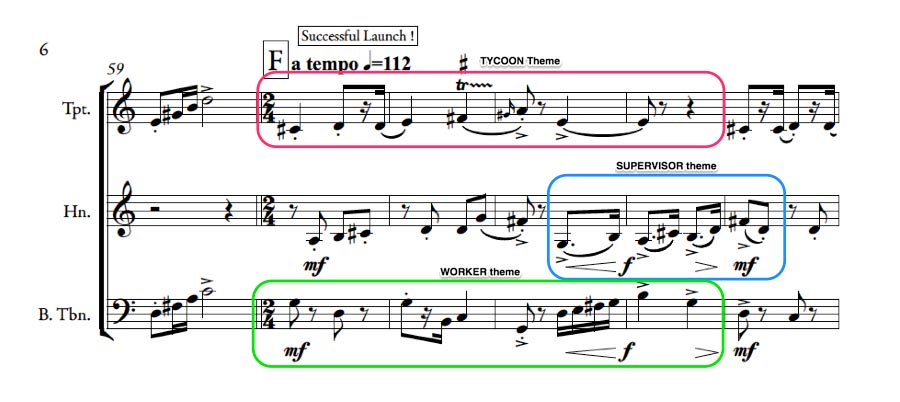
The horn represents Supervisor. He is highly organized and attracted to his Boss’s power yet disturbed by his lack of attention. He hires the workforce while separating the top and bottom of the company from knowing too much about the other. The Supervisor’s theme, circled in blue, is the dotted 8th – 16th long-short-long-short rhythm theme of thirds moving up in sequence. The Supervisor character was brought to life by Pawel Biegaj, Witek’s brother and Cirque colleague. The horn part was played by Juan Berrios. Both Pawel and Juan wore suit jackets and bowler hats.
The trombone represents the Worker. He is dependable. Sometimes he keeps the company going when the Management is fighting or making bad decisions. He expects the top of the company to work harder than he does. The Worker was the audiences’ favorite – played by Cirque du Soleil’s counter-tenor Ralph Daniel Rawe. Joey Vascik was the trombonist. Both Ralph and Joey wore black ‘wife-beater’ A-shirts and mini-bowlers.
The Worker’s theme establishes a tonal center: either in 1-5-1 fashion or a glissando or series of 16th notes up to the tonic. Modern techniques provided me with the notational means of stretching, pulling, struggling, and fighting that vaudeville musicians never had. This requires exemplary musicianship, however – this is not an easy piece to play. The recording here by Benoit Glazer, Juan Berrios, and Joey Vascik showcases their advanced technique and musicianship.
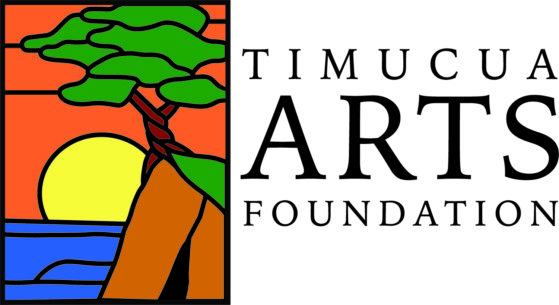

What I learned
Visuals are more robust than music. The audience loved the mimes and the story they told, but no one in the audience that I interviewed afterward could remember the music. It seems that with memory, most people remember what they see more than what they hear. This is important!
I also learned that working with mimes, essential plot points are all that is needed. Details are not required and could crowd their skills: their craft fills in the details in hilarious ways.
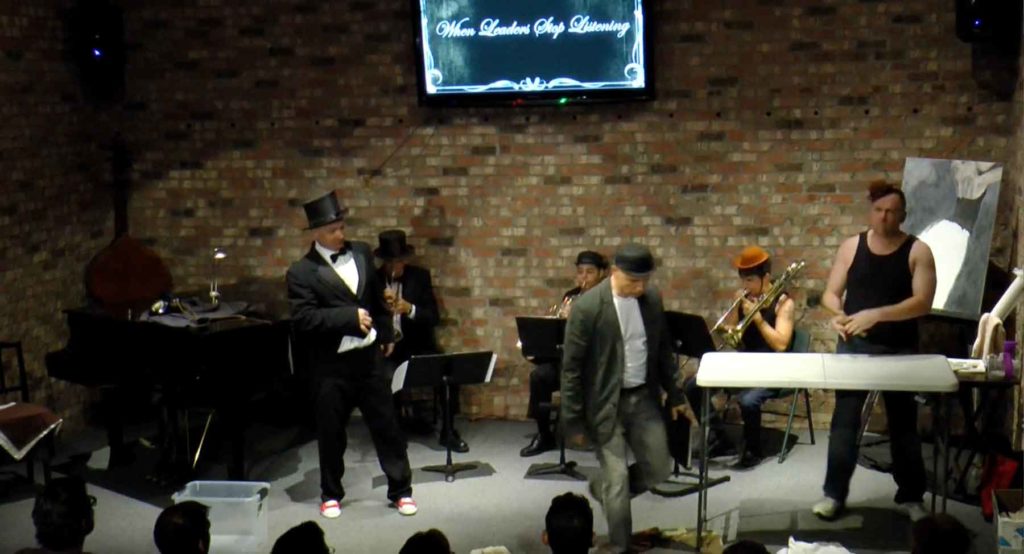
My deepest gratitude is to Benoit Glazer, who decided to find the players AND the mimes to allow this premiere to happen. He also produced this rehearsal version for the mimes that included a voiceover from the acting notes on my score.
Thanks
Studio Recording with Commentary for Mimes
- to Juan Berrios and Joey Vascik for rehearsing and playing on their own time, traveling a distance
- Benoit, Juan and Joey for your high musicianship – putting together this difficult work – and recording it !
- Witek, Pawel and Ralph, who gave me an hour after their grueling shows at Cirque for three nights – and for their suggestions and contributions that made this complex plot work theatrically. None of this could have happened without them
- Central Florida Composers Forum (CF2) and Eric Brooke who created this event and placed this work on the program
- the excellent audience at Timucua – who had a great time with this modern music! We are Orlando!!
This work was originally composed in 2009 and revised in 2011. Revised again with the addition of Three Mimes in 2015 for Benoit Glazer, Juan Berrios and Joey Vascik, First Performance: September 13th, 2015 CF2 2015 Salon Concert, Timucua White House, Orlando, FL
